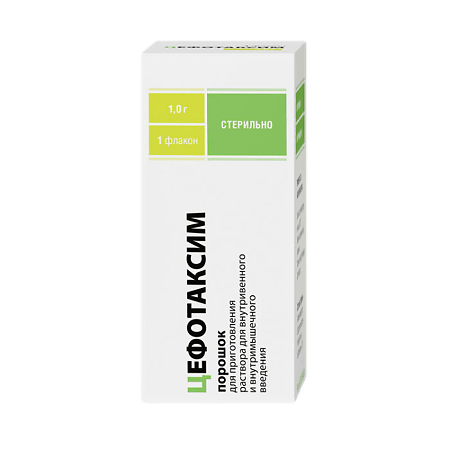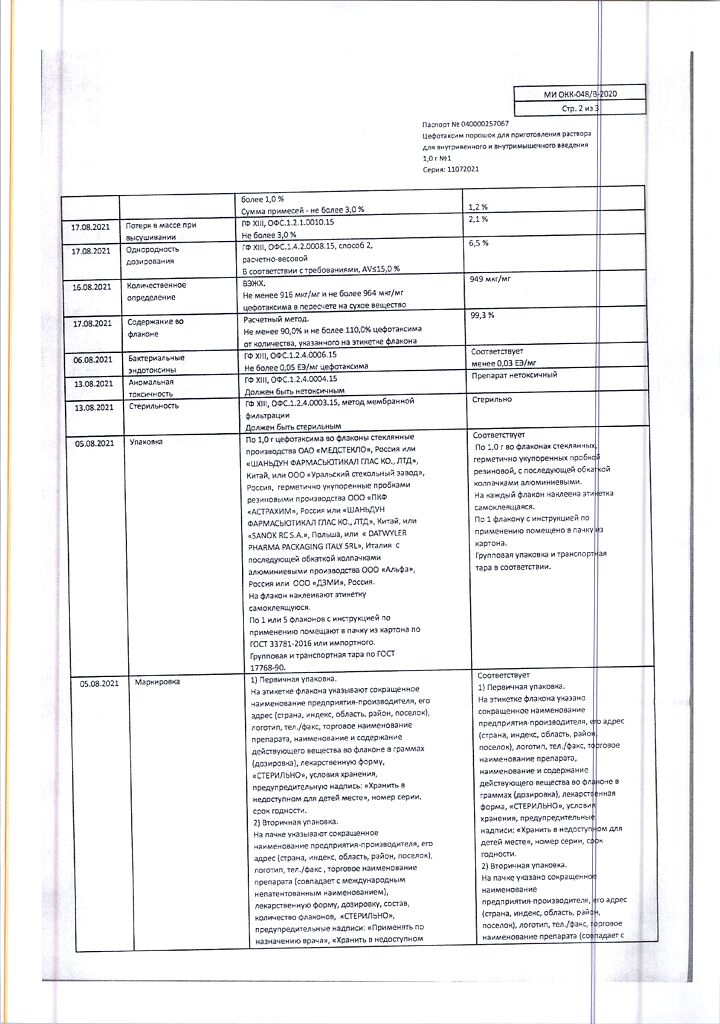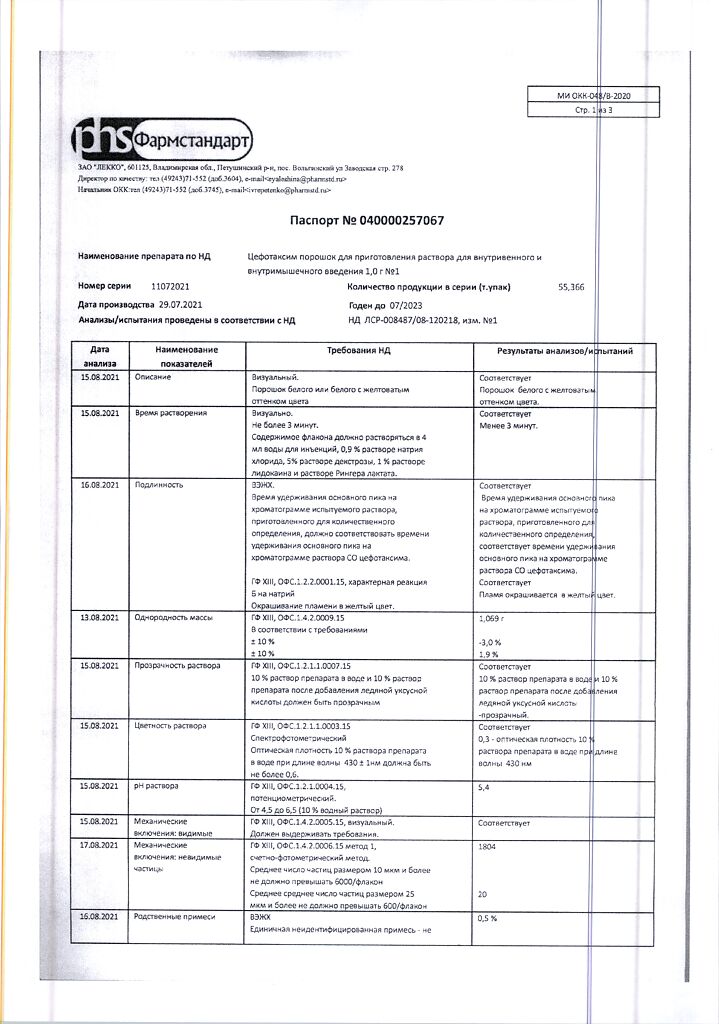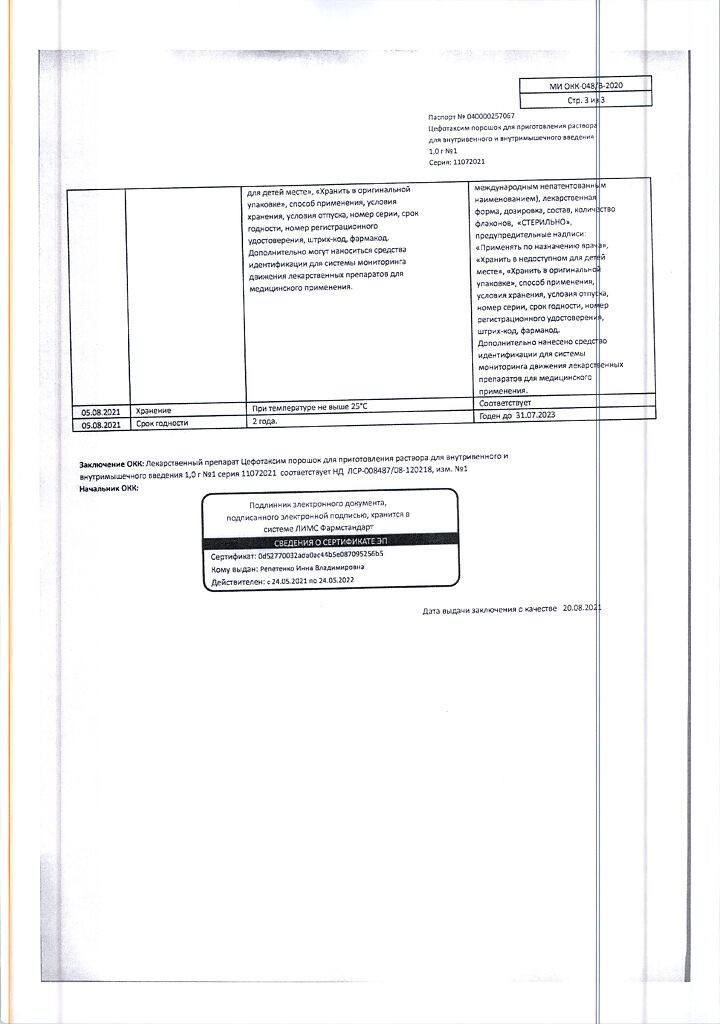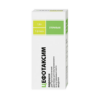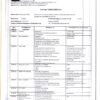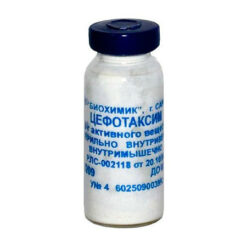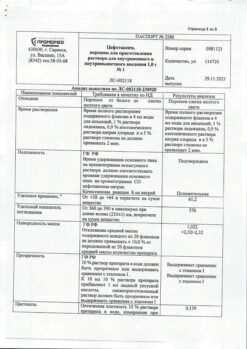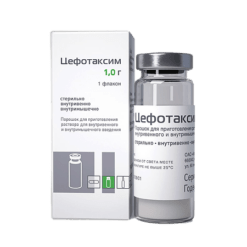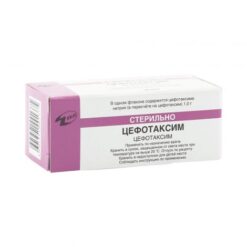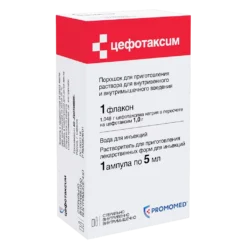No products in the cart.
Description
Pharmacodynamics
A III generation cephalosporin antibiotic for parenteral administration. It acts bactericidally by disrupting synthesis of mucopeptide of the cell wall of microorganisms. It has a wide spectrum of action. Cefotaxime is usually sensitive to: Aeromonas hydrophila; Bacillus subtilis; Bordetella pertussis; Borrelia burgdorferi; Moraxella catarrhalis; Citrobacter diversus*; Citrobacter freundii*; Clostridium perfringens; Corynebacterium diphtheriae; Esherichia coli; Enterobacter spp.*; Erysipelothrix insidiosa; Eubacterium spp.; Haemophillus spp. (penicillinase-producing and non-producing strains, including ampicillin-resistant strains); Klebsiella pneumoniae; Klebsiella oxytoca; Staphylococcus spp. (methicillin-sensitive, including penicillinase-producing and nonproducing strains); Morganella morganii; Neisseria gonorrhoea (including penicillinase-producing and nonproducing strains); Neisseria meningitidis; Propionibacterium spp.Proteus mirabilis; Proteus vulgaris; Providencia spp.; Streptococcus spp. (including Streptococcus pneumoniae); Salmonella spp.; Serratia spp.*; Shigella spp.; Veillonella spp.; Yersinia spp.*; Pseudomonas spp. (except Pseudomonas aeruginosa, Pseudomonas cepacia).
* – sensitivity depends on epidemiological data and on the level of resistance in each specific country.
The following are resistant to cefotaxime: Acinetobacter baumanii; Bacteroides fragilis; Clostridium difficile; Enterococcus spp.; Gram-negative anaerobes; Listeria monocytogenes; Staphylococcus spp. (methicillin-resistant strains); Pseudomonas aeruginosa; Pseudomonas cepacia; Stenotrophomonas maltophilia.
Pharmacokinetics
In adults – 5 minutes after a single intravenous (IV) injection of 1 g of cefotaxime the maximum concentration (Cmax) in blood plasma is 100 µg/ml. After intramuscular (i/m) injection of cefotaxime at the same dose, Cmax in plasma is reached after 0.5 hours and is 20-30 mcg/ml. Bioavailability of cefotaxime when administered intravenously is 100%, when administered intravenously – 90-95%.
The half-life (T1/2) of cefotaxime is 1 hour in intravenous and 1-1.5 hours in perinatal administration.
The binding to plasma proteins (predominantly albumins) is on average 25-40%.
It is metabolized in the liver with the formation of the active metabolite deacetylcephotaxime (M1), which has antibacterial activity, and inactive metabolites (M2, M3).
About 90% of the administered dose is excreted by the kidneys: 50% unchanged, about 15-25% as the deacetylcephotaxime metabolite and 15-30% as inactive metabolites (M2+M3). 10% of the administered dose is excreted by the intestine.
In elderly patients over 80 years old the T1/2 of cefotaxime is increased up to 2.5 h. The volume of distribution (Vd) does not change compared to young healthy volunteers.
In adults with impaired renal function, Vd is unchanged and the T1/2 does not exceed 2.5 h, even in the last stages of renal failure.
In children the plasma concentration of cefotaxime and Vd are similar to those in adults receiving the same dose of the drug in mg/kg of weight. The T1/2 is 0.75 to 1.5 h.
In newborns and prematurely born children the plasma concentration of cefotaxime and Vd are similar to those in children. Mean T1/2 of cefotaxime is 1.4 to 6.4 h.
Indications
Indications
Infections caused by microorganisms sensitive to the drug:
– Central nervous system infections, including meningitis (except listeria);
– Respiratory tract infections;
– Urinary tract infections (including gonorrhea);
Active ingredient
Active ingredient
Composition
Composition
Active ingredient:
Cefotaxime sodium converted to cefotaxime – 1.0 g.
How to take, the dosage
How to take, the dosage
Intravenously or intramuscularly.
The dose, route and frequency of administration should be determined by the severity of the infection, the sensitivity of the pathogen and the patient’s condition.
The treatment can be started before the results of the sensitivity test are available.
Adults and children over 12 years of age and with body weight 50 kg or more: in infections of mild to moderate severity – 1 g every 12 hours. The dose may vary depending on the severity of the infection, the sensitivity of the pathogen and the patient’s condition. In severe infections the dose may be increased up to 12 g per day divided into 3 or 4 injections.
In infections caused by Pseudomonas spp. the daily dose should be more than 6 g.
Children under 12 years of age and with a body weight under 50 kg: the usual dose is 100-150 mg/kg/day, divided into 2 to 4 injections. In very severe infections, the dose may be increased to 200 mg/kg/day.
Infants: 50 mg/kg/day, divided into 2-4 injections. For severe infections, a dose of 150-200 mg/kg/day, divided into 2-4 injections.
In gonorrhea: 1 g once intravenously or intramuscularly.
To prevent infections, 1 g intramuscularly or intravenously before surgery (30 to 90 minutes before surgery).
In case of caesarean section, 1 g of the drug is administered intravenously at the time of placing clamps on the umbilical vein, then after 6 and 12 hours 1 g is repeatedly administered intravenously or intramuscularly.
In cases of renal failure
In cases where creatinine clearance is less than 10 ml/min, the dose should be reduced. After administering the initial single dose, the daily dose should be halved without changing the frequency of administration, i.e., instead of 1 g every 12 hours, 0.5 g every 12 hours, instead of 1 g every 8 hours, 0.5 g every 8 hours, instead of 2 g every 8 hours, 1 g every 8 hours, etc. Further dose adjustments may be required depending on the course of the infection and the patient’s general condition.
Regulations for preparation of solutions
For intravenous injection, water for injection is used as a solvent (1 g diluted in 4 ml); when injected intravenously, the solution should be injected within 3 to 5 minutes.
In intravenous infusion 0.9% sodium chloride solution or 5% dextrose solution (1-2 g diluted in 40-100 ml of solvent) is used as a solvent. Ringer’s lactate solution can also be used. The duration of infusion is 20-60 minutes.
For intramuscular administration water for injection or 1% lidocaine solution (1 g diluted in 4 ml of solvent) is used.
Interaction
Interaction
Probenecid delays excretion and increases plasma concentrations of cephalosporins.
As with other cephalosporins, cefotaxime may increase the nephrotoxic effect of drugs with nephrotoxic effects (such as furosemide, aminoglycosides).
Prompts for compatibility
Cefotaxime should not be mixed with other antibiotics (including aminoglycosides), either in the same syringe or in the same infusion solution.
The following solutions may be used for infusion (cefotaxime concentration 1 g/250 ml): water for injection; 0.9% sodium chloride solution; 5% dextrose solution; Ringer’s lactate solution; Jonosteril.
Special Instructions
Special Instructions
Anaphylactic reactions
The prescription of cephalosporins requires an allergic history (allergic diathesis, hypersensitivity reactions to β-lactam antibiotics).
If a patient develops a hypersensitivity reaction, treatment must be discontinued.
The use of cefotaxime is contraindicated in patients with a history of immediate hypersensitivity reactions to cephalosporins. If there is any doubt, the presence of a physician during the first instillation of the drug is mandatory due to a possible anaphylactic reaction.
Cross-allergy between cephalosporins and penicillins is known to occur in 5-10% of cases. Anaphylactic reactions developing in this situation can be serious and even fatal.
In patients with a history of allergy to penicillins, the drug is used with extreme caution. The patient’s condition should be monitored closely during the first instillation of the drug due to possible anaphylactic reaction.
In case of the first symptoms and signs of anaphylactic shock the drug administration should be stopped immediately. The patient should remain in the supine position with elevated legs. Slow intravenous injection of 0.1 mg (1 ml) of epinephrine (Adrenaline) solution under control of pulse and blood pressure is indicated, as well as intravenous injection of plasma substitutes, human albumin or balanced electrolyte solutions; subsequently, intravenous injection of glucocorticoids (e.g. 250-1000 mg hydrocortisone), once or repeatedly if necessary. Supportive therapeutic measures should be carried out: artificial lung ventilation, oxygen inhalation, administration of antihistamines.
Diseases caused by Clostridium difficile (e.g., pseudomembranous colitis)
Diarrhea, especially severe and/or prolonged, that develops during treatment or in the first weeks after treatment with various antibiotics, especially broad-spectrum antibiotics, can be a symptom of a disease caused by Clostridium difficile, the most severe form of which is pseudomembranous colitis. The diagnosis of this rare but possibly fatal disease is confirmed endoscopically and/or histologically. The most important method of confirming the diagnosis of pseudomembranous colitis is the detection of Clostridium difficile toxins in the feces. If the diagnosis of pseudomembranous colitis is suspected, cefotaxime should be stopped immediately and appropriate antibiotic therapy (e.g. oral vancomycin or metronidozole) started immediately. Drugs that inhibit bowel peristalsis are contraindicated.
The use of lidocaine as a solvent
When using lidocaine as a solvent, the information under “Contraindications” should be noted.
The rate of administration
The rate of administration must be controlled (see section “Administration and Doses”).
Renal failure
The dose should be adjusted according to creatinine clearance if there is renal failure (see section “Administration and Doses”).
Caution should be exercised when using cefotaxime and aminoglycosides concomitantly.
Renal function should be monitored in all cases of combined use of cefotaxime with aminoglycosides, other nephrotoxic drugs, elderly patients or patients with renal impairment.
The sodium content of cefotaxime sodium salt (48.2 mg/g) should be taken into account in patients requiring sodium restriction.
Hematopoietic disorders
When treated with cefotaxime, leukopenia, neutropenia and more rarely bone marrow hematopoiesis failure, pancytopenia and agranulocytosis may develop. During the treatment course of more than 10 days the number of blood cells should be monitored. If there are deviations from normal blood counts the drug should be discontinued.
Laboratory tests
A positive Coombs test may occur during therapy with cephalosporins.
The use of glucose oxidase methods to determine blood glucose concentration is recommended because of the development of false-positive results when using nonspecific reagents.
Effect on driving, operating machinery
If side effect such as dizziness develops, concentration and reactions may be impaired. In this case, patients should refrain from driving vehicles and operating machinery.
Synopsis
Synopsis
Contraindications
Contraindications
– hypersensitivity to cefotaxime and other cephalosporins.
For forms containing lidocaine as a solvent:
– hypersensitivity to lidocaine or another amide-type local anesthetic;
– intracardiac blockages without an established pacemaker;
– severe heart failure;
– intravenous administration;
– children under 2.5 years of age (for intramuscular administration).
With caution
– in patients with a history of allergy to penicillins (risk of cross-allergic reactions) (see section “Special Precautions”);
– when used concomitantly with aminoglycosides (see sections “Special Precautions”).
– concomitant use with aminoglycosides (see sections “Cautions” and “Interaction with other medicinal products”);
– in renal insufficiency (see section “Dosage and administration”).
Side effects
Side effects
Classification of adverse reactions by frequency of development, according to WHO recommendations: very common (â¥10%); common (â¥1% and <10%); infrequent (â¥0.1% and <1%); rare (â¥0.01% and <0.1%); very rare (<0.01%); frequency is unknown (based on available data, the frequency of side effects cannot be estimated).
Infectious and parasitic diseases:
Frequency not known: superinfections. As with the administration of other antibiotics, use of cefotaxime, especially prolonged use, may lead to an overgrowth of insensitive microorganisms. The patient’s condition should be monitored regularly. If superinfection occurs during cefotaxime therapy, appropriate measures should be taken.
Disorders of the immune system:
Infrequent: Jarisch-Herxheimer reaction. As with the use of other antibiotics, a Jarisch-Herxheimer reaction may develop during the first days of therapy when treating borreliosis. There are reports of the occurrence of one or more symptoms after a few weeks of borreliosis treatment: skin rash, itching, fever, leukopenia, increased liver enzyme activity, difficulty in breathing, discomfort in the joints.
Prevalence unknown: anaphylactic reactions, angioedema, bronchospasm, anaphylactic shock.
Nervous system disorders:
Infrequent: seizures.
Prevalence unknown: headache, dizziness, encephalopathy (e.g., impaired consciousness, impaired motor activity).
Skin disorders:
Infrequent: rash, itching, urticaria.
Prevalence unknown: acute generalized exanthematous pustulosis, erythema multiforme, Stevens-Johnson syndrome, toxic epidermal necrolysis.
Disorders of the urinary system:
Infrequent: decreased renal function/increased creatinine concentration, especially when combined with aminoglycosides.
Infrequent unknown: interstitial nephritis, acute renal failure.
Disorders of the digestive system:
Infrequent: diarrhea.
Prevalence unknown: nausea, vomiting, abdominal pain, pseudomembranous colitis. Liver and biliary tract disorders:
Infrequent: increase of “liver” enzymes activity (alanine aminotransferase, aspartate aminotransferase, lactate dehydrogenase, gamma-glutamyltransferase, alkaline phosphatase) and/or bilirubin concentration. These abnormal laboratory values (which can also be explained by the presence of infection), rarely exceed the upper limit of the norm by a factor of 2 and indicate liver damage manifested by cholestasis and often asymptomatic.
Prevalence unknown: hepatitis (sometimes with jaundice).
Hematopoietic disorders:
Infrequent: leukopenia, eosinophilia, thrombocytopenia.
Prevalence unknown: hemolytic anemia, neutropenia, agranulocytosis, insufficiency of medullary hematopoiesis, pancytopenia.
Disorders of the cardiovascular system:
Prevalence unknown: arrhythmias after rapid bolus administration via central venous catheter.
General disorders and disorders at the site of administration:
Often: pain at the injection site (when administered intramuscularly).
Infrequent: fever, inflammatory reactions at the injection site, including phlebitis/thrombophlebitis.
Prevalence unknown: In intramuscular injection, if lidocaine is used as a solvent, systemic reactions associated with lidocaine may develop.
Overdose
Overdose
Symptoms: convulsions, encephalopathy (in case of high doses, especially in patients with renal failure), tremor, neuromuscular excitability.
Treatment: symptomatic, no specific antidote.
Pregnancy use
Pregnancy use
Similarities
Similarities
Additional information
| Weight | 0.020 kg |
|---|---|
| Shelf life | 2 years. |
| Conditions of storage | Store at the temperature not more than 25 ° C. Keep out of reach of children. Keep in the original package. |
| Manufacturer | Lekko ZAO, Russia |
| Medication form | Powder for preparation of solution |
| Brand | Lekko ZAO |
Other forms…
Related products
Buy Cefotaxime, 1 g with delivery to USA, UK, Europe and over 120 other countries.

